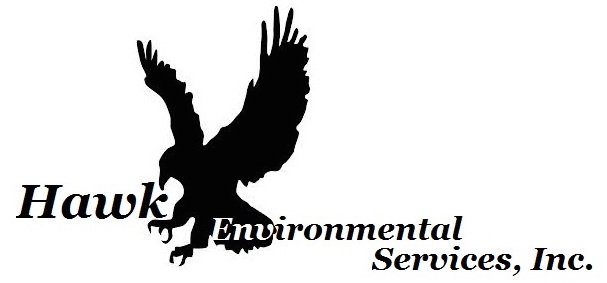
A study from 2017 concluded that 4.5 million U.S. homes were at a high risk of wildfire, with a little under half of that number being homes in California alone. The pace of a wildfire can increase incredibly quickly, and its effects can ruin land, damage air quality, and dangerously threaten lives within a matter of hours.

In recent years we’ve seen prime examples of the wrath of wildfires. From the California wildfire tragedies of last year (with a death toll of 42, it became the deadliest wildfire in the state’s modern history) to the thick blanket of ash and smoke that has covered Seattle’s blue skies and degraded our air quality the last few summers as a result of several fires in Eastern Washington, Portland, and British Columbia. In fact, the air quality in Seattle during the Summer of 2018 was at times considered to be worse than anywhere else in the world.
10 percent of these fires are caused naturally by things such as lightning or lava in the environment, but the vast majority are unfortunately caused by human action, whether from abandoned camp fires and downed power lines, or even intentional arsonist acts.
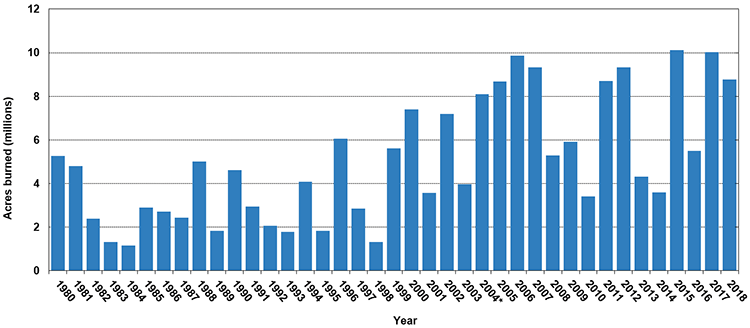
Annual Number of Acres Burned in Wildland Fires, 1980-2018
Source: National Interagency Fire Center
Being knowledgeable about wildfires, the smoke they emit, and how to protect yourself, your home, and your loved ones from future risk is an important step toward reducing the harm wildfires can cause and maintaining fresh, safe airflow indoors during the warmer months.
What Is Wildfire Smoke?
The smoke caused by wildfires is made up of a complex combination of gas, water vapor, carbon dioxide, ash, and fine particles from burning plant materials. When you breathe in wildfire smoke, you may also be breathing in hazardous gaseous chemicals such as carbon monoxide, methane, acetic acid, and formaldehyde.
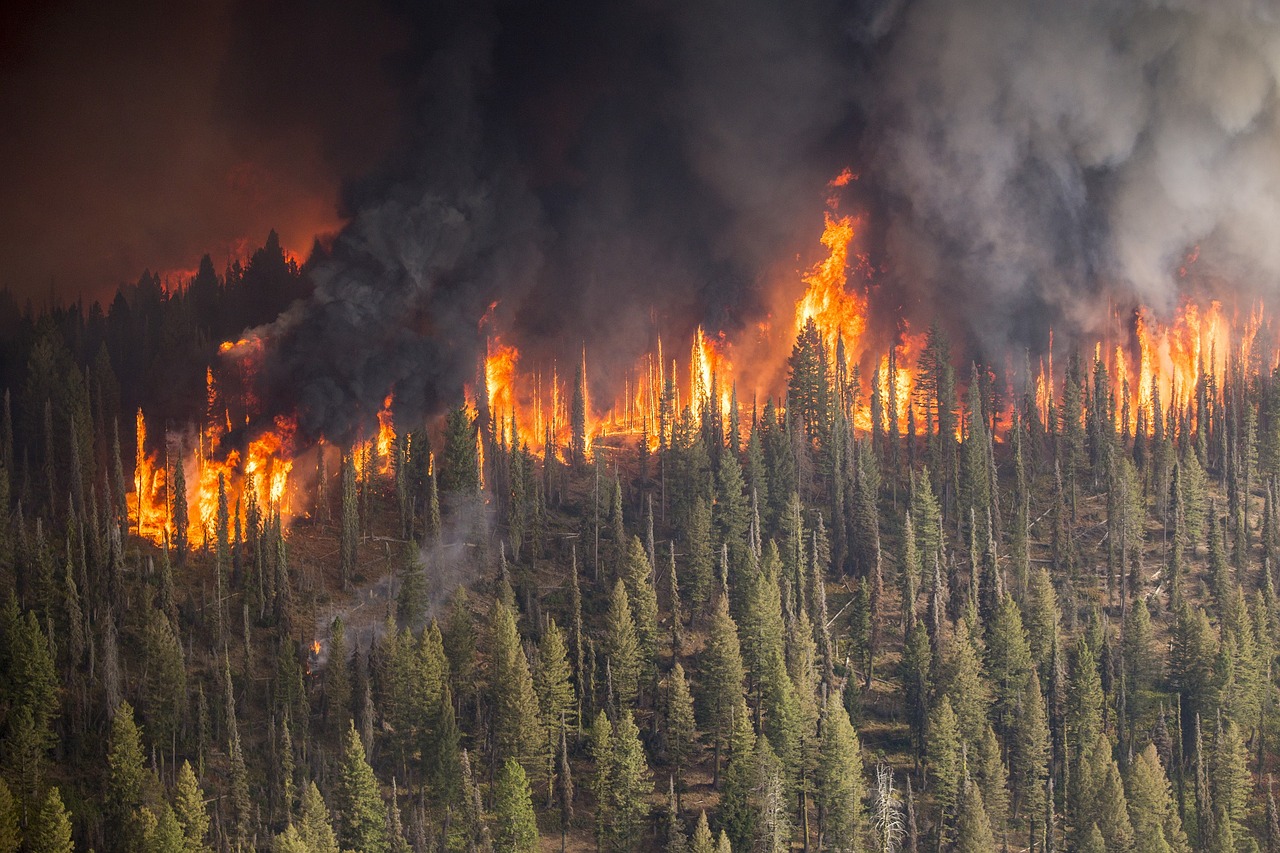
Burning plant materials that create the fine particles in the air are less than a fraction of the diameter of a human hair, and so are easily inhaled and enveloped into the bloodstream. This smoke creates a decline in air quality, and causes symptoms such as shallow breathing, wheezing, coughing, runny nose, and burning eyes.
Whose Health Is Most Affected by Wildfire Smoke?
Although wildfire smoke can negatively affect anyone near the impacted area, it especially takes its toll on those with preexisting conditions of asthma, heart disease, and lung disease, as well as the elderly and the very young because of their weaker immune systems. Pregnant women may or may not be more at risk, as the research isn’t conclusive.
Where Do Wildfires Occur?
Although wildfires can happen anywhere with dry forest vegetation and high winds, certain areas have historically been more prone to wildfire activity, such as vegetated areas of Australia, the Western Cape province of South Africa, and the forests and grasslands of North America. In the United States, western states such as Nevada, Oregon, Washington, Arizona, and particularly California are most prone to wildfires.
California is one of the hot spots for wildfires because of several factors, including its long dry season, its large population, strong gusts of dry winds called “the Santa Anas,” and of course, climate change. In 2017, 9,000 wildfires burned more than one million acres of land in California, and wildfires in Washington and Oregon extended three weeks longer than ever recorded.

Source: PA Environment Digest Blog
That year Oregon experienced its largest ever wildfire, the Chetco Bar Fire in the Kalmiopsis Wildnerness, which started after a lightning strike, and burned 191,125 acres until it was officially contained in November of 2017.
Last year, by July 3rd, Washington state had already experienced close to 900 wildfires, burning up approximately 113,000 acres of land before a state of emergency was called by Governor Jay Inslee.
What Is an Air Quality Index?

While the rest of the United States has a healthy average recorded air quality index (AQI), the patch of western states highly affected by wildfires has a steadily increasing AQI. The higher the AQI, the greater the level of air pollution and cause for health concern.
For example, an AQI of 50 is considered healthy, while an AQI over 300 represents a dangerous air quality. An AQI of 51 to 100 is generally acceptable, and an AQI above 100 is considered to be unhealthy for “at-risk” individuals (the elderly, the very young, and the immune-compromised).
Because of our plentitude of wildfires, to the north, east, and south of us, Seattle remains one of the worst cities for healthy air quality index. Seattle is now the ninth most polluted metro area for short-term particle pollution with a letter grade of “F” according to the American Lung Association’s “State of the Air” report.
What Should I Do in the Case of a Wildfire?
In the case of a wildfire, several steps can prepare you and help you get through the situation.

Have a Plan
Find out if your neighborhood or community has an evacuation plan, and establish several routes to leave the area and find shelter. Create an individual plan of evacuation for your own home and family members, ensuring that any children in your household also know what to do and where to go. Have a plan for your livestock or pets as well, and create emergency supply packs that include respiratory masks, food and water, flash lights, extra batteries, and medications and other health resources for your family and animals.
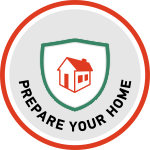
Prepare Your Home
If your home is in a wooded area or surrounded by vegetation (i.e. a wildfire-prone area), create a defensible space of rock or nonflammable material separating your home from flammable vegetation by a minimum of 30 feet. While doing this, make sure you are adhering to local fire and building codes and keep all electrical and power lines clear. Clear your chimneys and roof surfaces of pine needles, stack firewood away from your house, and keep a portable air scrubber nearby to help reduce indoor air pollution levels during smokey conditions, or equip your home with a whole-house HEPA filter. Keep important documents in a fireproof safe and protect digital copies with online passwords.

Stay Alert
Stay in the know by listening for evacuation warnings and AQI alerts from the Emergency Alert System, National Oceanic and Atmospheric Administration Weather Radio, and your local news station. If a medical emergency occurs or you’re trapped, call 911 and turn on the house lights to help rescuers find you.
To prep for first responders during a wildfire where you are not sure if you need to evacuate yet, fill buckets with water, prop up a ladder against the house for roof access, keep your keys ready to go in your vehicle, move combustible material and upholstered furniture away from the windows, and secure all animals and pets. Remember never to return to your home after an evacuation until you get the okay, and use extreme caution when reinhabiting a space affected by wildfire.
How Can Air-Sealing Protect My Home?
Air-sealing a home or other building is one of the best ways to improve energy efficiency and moisture migration and limit the amount of outdoor air that enters the building. While these techniques initially served to prevent the loss of heated air and conserve energy, they can also be used to prevent smoke from wildfires from entering your home. In essence, air-sealing is the process of filling in gaps, cracks, and other spaces where air can find a pathway from one space (outdoors) into the adjacent space (indoors). Many different tactics work to accomplish this.

Source: YourHome
All contractors involved in the construction or renovation of the property should be informed and trained on the basics of building envelopes. The envelope is the barrier between the conditioned space (the interior of the home) and unconditioned space (the exterior, attic, or crawlspace). Once you have properly trained and informed staff on the job, the project supervisor should be responsible for checking this work and ensuring that no one cuts any corners. A final quality control measure would be the use of a blower door test to document remaining building leakage amounts.
What Should Professionals Do to Air-Seal My Home During Construction?
What if My Older Home Wasn’t Air-Sealed to Modern Standards During Construction?
As energy costs have become more expensive and the government rebates for making buildings more energy-efficient have risen, many resources for sealing buildings have become available to the consumer. A whole industry is devoted to making homes more energy-efficient through air-sealing; the people who work in this industry are often referred to as “weatherization contractors.” Additionally, the government has put together many informative resources for homeowners that wish to weatherize their homes.
How Important is Sealing Doors and Windows?
The largest hole in any home or building is generally a window or door; collectively these are called fenestrations. When windows and doors are open, we know that air can easily move in and out, but what about when they are closed?
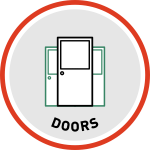
Doors
Your bedroom door (and other interior doors) are very different from your front door (an exterior door). Beyond just the material that the door is made of, the tolerances with which the door seals to the jamb and the weather-stripping or seals make a huge difference. On the interior of our homes, doors are designed to provide privacy and a general visual barrier; but exterior doors are designed to seal tightly to prevent heat loss and water intrusion.

Windows
A high-quality window will be designed to close completely and latch shut for years to come. This includes a locking or latching mechanism that is secure and forces the window to seat fully into the outer frame. Between the window and the frame will be a gasket or foam strip that, when compressed, fully prevents the loss of warm air or infiltration of outdoor air. Some windows have “trickle vents” that are small slots or ports designed to allow fresh air into the home when they are opened. Ensure that these trickle vents are fitted with a gasketed cover so that air does not seep in when they are closed.
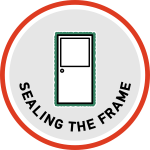
Sealing the Frame
A window or door consists of the operable portion (door slab or window sash) and the outer frame. These square or rectangular fenestrations are installed into the rough opening that was built by the carpenter, and are typically at least an inch larger than the window frame.
When properly installed, the window or door should close tightly, forming a proper seal on all four sides so that no light is visible in the gaps and no air movement is felt. If the window or door is improperly installed or the building has settled over time, the frame can become “out of square,” leaving gaps and cracks where air can leak in even when the fenestration is in the closed position.
Hiring skilled contractors and taking the time needed to apply foam sealant between the rough opening and the window or door frame is necessary to get the full benefits of an air-sealed fenestration.
Can I Use AC During a Wildfire?
Running your central air or air conditioning units during a wildfire is safe because the outside air isn’t replacing your indoor air with smoke — the machine is simply expelling hot air and exchanging it. Keep the fresh-air intake on your machine closed, and shut windows and doors in order to keep the air inside as clean as possible. Your AC filters should be as clean as possible and changed frequently during smokey events in order to reduce the amount of smoke particles that get through, and central air systems should be set to recirculate to avoid drawing in smoky air.


Air scrubbers or portable air cleaners or a whole-house filter may be a better option for keeping your indoor air as clean as possible, especially when paired with high-efficiency filter bags with activated charcoal and other adsorbents.
How Do I Create a “Clean Air Room”?
A clean air room should be a space of sanctuary during a time when the outdoors may be smoky or have a hazardous AQI. In order to create a clean air room, find a room in the house that has very few doors and windows and no fireplace. Make sure any doors and windows can be properly secured, and set up a portable air cleaner.

This room should be free of all candles, stoves, aerosol sprays, tobacco products, vacuums, or anything that may compromise the integrity of the fresh air inside that room.

How Can I Remove Smoke Odors?
After a fire, strong odors leftover from wildfire smoke can be persistent and difficult to remove from the materials around your home. Completely removing all traces of these odors is difficult, and contacting a restoration professional is the best way to effectively deodorize compromised areas and clean air ducts and furnaces.

If you’d like to try out some do-it-yourself methods of smoke odor removal, you can fill bowls with baking soda or activated charcoal and place them around the house to absorb the smell.
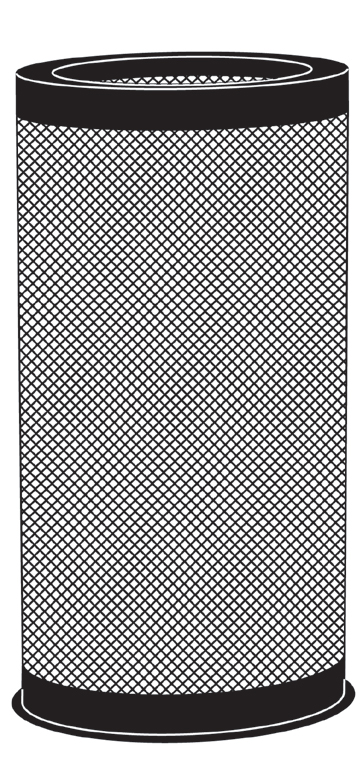 Activated carbon filters work wonders with adsorption, drawing unclean air and odors to the carbon on the surface of the charcoal and clearing your home of impurities and air pollutants.
Activated carbon filters work wonders with adsorption, drawing unclean air and odors to the carbon on the surface of the charcoal and clearing your home of impurities and air pollutants.
You can also wash any compromised clothing items with one cup of vinegar in addition to normal washing detergent. Do not dry your clothes fully until the smell is out, since drying the clothing with the odor still intact may make it worse and harder to get rid of. For your home, power wash the exterior of your house, the driveway, and the sidewalks and disinfect all indoor walls and surfaces with mild natural soap and cleaning products.
What Is the Future of Fireproof Homes?
With wildfires unfortunately beginning to reach neighborhoods and communities more frequently than ever before, the possibility of fireproofing homes becomes a serious consideration. A Las Vegas manufacturing company called GigaCrete is making prefabricated homes rapidly assembled with steel frame systems made from nonflammable and recyclable materials. The homes are put together similarly to Lego blocks, with pieces interlocking and covered in special proprietary coatings making the home bulletproof, waterproof, fireproof, and extremely insulated.

Homes can achieve a high level of safety from fires if they use steel for outside stairways and railings, fire-resistant wood on the exterior, stucco walls with no open seams, concrete pavers and tiles, no roof vents, tempered glass, flame-resistant roofing and siding, and aluminum doors and windows. Creating a gravel or stone buffer separating your home from outside forests and vegetation by a minimum of 30 feet will also help to fireproof your home and keep your family safe.
How Does Climate Change Affect Wildfires?
The role of climate change in the occurrence of wildfires is a cyclical one. Wildfires affect climate change, and climate change also affects the frequency of wildfires.
One of the leading causes of climate change, or global warming, is the burning of fossil fuels. As climate change lengthens the seasons of dry, hot weather, wildfires have more time to start and grow quickly. Wildfires then emit carbon dioxide and other gases that will continue to warm the planet and damage forests that would otherwise remove carbon dioxide from the atmosphere — sometimes permanently. Scientists estimate that wildfires make up 5 to 10 percent of the earth’s annual global CO2 emissions. This suggests that, specifically in places like California, wildfires may be releasing enough CO2 to endanger progress toward greenhouse gas reduction.

Being informed about wildfires and how they can affect your family, health, and home is one of the most important things you can do, especially if you live in a wildfire-prone area such as the western United States. Talk with your family about emergency plans, map out evacuation routes, create kits to prepare yourself, and research ways to fireproof your home as much as possible. The DNR offers additional resources to help prepare for wildfires, including an active wildfire map and local emergency management contacts.
Contact Hawk Environmental today to inquire about the several different air quality tests and inspections we can do for you and your home, and what products we might recommend to keep your air clean and your family happy and healthy.
